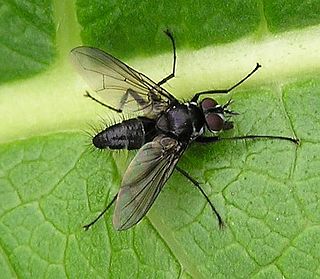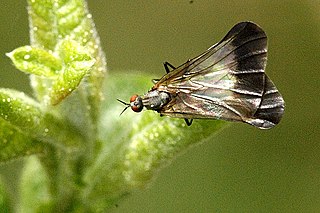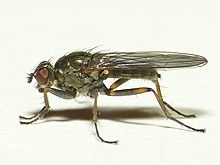
Tachydromia is a genus of hybotid flies. It is widespread around the world, with species found essentially everywhere except the polar regions and some remote islands. They are not very diverse in East and Southeast Asia, or in Africa

Rhagio is a worldwide genus of predatory snipe flies. Several species in this genus are referred to as downlooker or down-looker flies because they sometimes perch on tree trunks in a head-down position. There are approximately 170 species. They can be distinguished from other rhagionids by the open anal cell on the wings and the lack of a kidney-shaped arista.

The genus Scathophaga are small to medium sized predatory flies that for the most part, have larvae that feed on other insect larva within animal dung or decaying vegetable matter. Many are highly variable, sometimes producing small, infertile males that superficially resemble females. This species is an example of an organism which may selectively store the sperm of multiple males, as females have three to four spermathecae.

Villa is a genus of flies belonging to the bee-fly family (Bombyliidae). They range in size from 5 to 17 millimetres, and have typically rounded heads. The males of some species have a brilliant mat of silvery patagial scales. About 270 Villa species are found on all continents except Antarctica. They can be distinguished from similar genera (Hemipenthes) by their wing venation.

Symphoromyia is a genus of predatory snipe flies. Unusually for Rhagionids, some species of Symphoromyia are known to feed on mammal blood, including human blood. Symphoromyia species are stout bodied flies from 4.5 to 9 mm and with a black, grey or gold thorax, and the abdomen is coloured grey, black, or both black and yellow, black terminating with yellow, to completely yellow. The wings are hyaline or lightly infuscate.

Admontia is a genus of flies in the family Tachinidae.

Athrycia is a genus of flies in the family Tachinidae.
Clairvillia is a genus of flies in the family Tachinidae.

Panzeria is a genus of flies in the family Tachinidae.

Medina is a genus of flies in the family Tachinidae.

Urophora is a genus of tephritid or fruit flies in the family Tephritidae.

Xyphosia is a genus of the family Tephritidae, better known as fruit flies.

Melieria is a genus of picture-winged fly in the family Ulidiidae.

Dexia is a genus of flies in the family Tachinidae. Most larvae are parasitoids of beetles (Scarabaeidae).

Rhamphomyia is a genus of dance flies, in the fly family Empididae. It contains more than 600 species in 8 subgenera.

Gonia is a genus of flies in the family Tachinidae.

Dexiini is a tribe of flies in the family Tachinidae.

The genus Norellia are small to medium sized predatory flies. Most of the species formally placed in this genus are now in the genus Norellisoma.

The genus Chaetosa are small to medium-sized predatory flies.

















